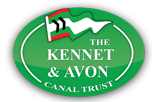

Powered by Camelot Media Ltd


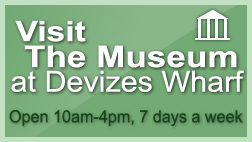
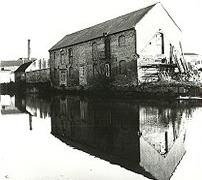
Devizes Wharf past and present
-------------------------------------------------------------------------------------------------------------------
Page Five
Wharves
Many more wharves existed in the 19th century than are in evidence today.
At Newbury two whole canal basins now lie beneath the library and car park.
At Reading the entire length of the river was lined with wharves.
Although today, only one wharf can be seen at the Wiltshire market town of Devizes, where there were once seven.
Approaching Devizes by canal from the west, one first encounters Marsh Lane Basin at the bottom of Caen Hill. Most of the western edge of this triangle of water was wharf with a basin in the north corner. The main trade here was in road materials and manure.
Above Caen Hill there was a dock where St Peter's Church now stands.
The Quaker meeting house now occupies what was Sussex Wharf, and old stables are still located on Lower Wharf, behind Wadworth's brewery.
After this comes Town Wharf, which is the only one remaining today and just before the canal bends sharply is what was once a stone wharf at London Road.
Finally there was a sand wharf near Coate Bridge from where very fine sand that was used in foundry casting, was transported to Bath and Bristol.
Technical and economic change including the loss of trade to railways and road transport resulted in a gradual run down and the closure of many of the once busy wharves all along the waterway.
--------------------------------------------------------------------------------------------------------------
Ancillary Trades
In its heyday the canal brought prosperity to the areas through which it passed, changing small rural villages such as for example Pewsey in Wiltshire, into relatively prosperous towns.
Not only did the canal provide an effective means for the transport of a myriad of goods, but it also enabled a number of ancillary trades and activities to flourish.
Waggoners
Some of the most prominent of these were the waggoners, who provided an essential service delivering goods to and from the wharves, and the wheelwrights who manufactured and repaired wheels for the carts and other vehicles that carried those goods.
Wheelwrights
At Great Bedwyn there was a wheelwright's shed on the wharf, and the last wheelwright operating from there ceased to trade in the 1940s.
Blacksmiths
Other associated trades included blacksmiths who not only produced much of the ironwork used on the canal but also provided the regular function of shoeing horses.
Stabling for horses
Horses also needed stabling and some of the original stable buildings are still in evidence along the canal, although most are now used for other purposes.
Boat building
Boat building was also an important ancillary trade, and in addition to large boat building concerns such as Robins, Lane and Pinniger at Honeystreet, it is likely that some craft were simply built on the side of the canal in a position where they could be easily launched side on.
Timber trade
Boats and barges for use on the K&A were mainly built using local timber from the Savernake Forest and from around the town of Hungerford.
Timber was labouriously reduced by sawing over sawpits, and knees and other acutely bent timbers were fashioned from branches which had naturally grown to the shape required.
The heavy oak timbers used for planks, were bent where required by steaming until supple enough to be forced into place around the boat or barges frames.
All this work was carried out with a minimum of tools and required great skill in application.
Plenty and Sons
Other local firms whose products supported the canal trade were Plenty and Sons of Newbury, who produced steam engines for pumping and other applications, and various sail and rope makers from whom canvas tarpaulins and sheeting to protect cargoes, and ropes for a myriad of uses, were purchased.
Acramans Cranes
Crane makers such as Acramans of Bristol also provided essential equipment, and installed their products on wharves along the canal.
The one remaining Acramans crane can still be seen at Dundas Wharf at Brassknocker Basin where it has stood since around 1830.
--------------------------------------------------------------------------------------------------------------
The Decline of the Canal
For thirty years traffic on the canal grew and grew, with annual receipts between 1824 and 1839 for example in excess of £42,000 with a dividend of 3%.
Railway competition
However as soon as the Great Western Railway started operating from London to Bristol in 1841, the competition started affecting canal trade.
Ironically much of the canal company's profit in the late 1830's, came from transporting those self same materials that were used to build the railway.
Fighting back
For the next ten years the canal company fought back against railway competition by reducing tolls and introducing its own fleet of barges.
New services
Increasing fly-boat services and extending passenger carrying facilities were other methods of remaining competitive that were tried.
Losing out to the GWR
Later as matters got worse there were staff cuts and wage reductions, and canal traders increasingly turned to the railway, viewing it as a more economical means of transporting their goods.
Railway Take-over and Operation
In 1852, the GWR obtained Parliamentary approval to take over the whole canal.
The canal company shareholders were guaranteed an annual payment, and the GWR promised to keep the canal in good repair and try to run it in a business like way.
However as profits gradually disappeared, they too began to cut staff and reduce repairs.
Toll charges
By 1906 tolls on the K&A were higher than those on similar waterways.
By 1914 railway competition had closed both the Somerset Coal Canal and The Wilts and Berks.
By 1920 some trading still existed on the K&A, although tolls had by then been raised by 150%.
Maintaining the canal
Obligations in the Act, together with local opposition prevented the canal being closed in 1926 and in 1929, the last major canal trader forced the GWR to honour its maintenance obligations, although trade was not encouraged.
The Kennet and Avon during World War Two
During the Second World War, the K&A was used as a second line of defence against possible invasion.
Pill boxes were strategically sited along the whole length of the canal, and concrete obstructions placed across canal bridges.
Much of the material used for these structures was carried on canal boats.
Canal Abandonment
During the years 1945 to 1948, the canal suffered even further decline due to a lack of maintenance and use although a number of smaller traders still used the waterway.
New management
As a consequence of railway nationalisation in 1948, the K&A came under the management of the Railway Executive and later under the Docks and Inland Waterways Executive (DIWE).
For a short while there was an upsurge in canal trading, when a number of enterprising businessmen found cargoes to carry.
Closure
However from the early 1950's the DIWE effected a number of closures for repairs, and this made trading more and more difficult.
These repairs were never satisfactorily carried out, and in 1955 the Transport Commission went to Parliament to close the canal.
A few years later and after considerable campaigning, the restoration of the Kennet and Avon Canal was started and the Kennet and Avon Canal Trust formed.
After several decades of fundraising and hard work, the Kennet and Avon was eventually re-opened by Her Majesty The Queen in August 1990.
Wharves
Many more wharves existed in the 19th century than are in evidence today.
At Newbury two whole canal basins now lie beneath the library and car park.
At Reading the entire length of the river was lined with wharves.
Although today, only one wharf can be seen at the Wiltshire market town of Devizes, where there were once seven.
Approaching Devizes by canal from the west, one first encounters Marsh Lane Basin at the bottom of Caen Hill. Most of the western edge of this triangle of water was wharf with a basin in the north corner. The main trade here was in road materials and manure.
Above Caen Hill there was a dock where St Peter's Church now stands.
The Quaker meeting house now occupies what was Sussex Wharf, and old stables are still located on Lower Wharf, behind Wadworth's brewery.
After this comes Town Wharf, which is the only one remaining today and just before the canal bends sharply is what was once a stone wharf at London Road.
Finally there was a sand wharf near Coate Bridge from where very fine sand that was used in foundry casting, was transported to Bath and Bristol.
Technical and economic change including the loss of trade to railways and road transport resulted in a gradual run down and the closure of many of the once busy wharves all along the waterway.
--------------------------------------------------------------------------------------------------------------
Ancillary Trades
In its heyday the canal brought prosperity to the areas through which it passed, changing small rural villages such as for example Pewsey in Wiltshire, into relatively prosperous towns.
Not only did the canal provide an effective means for the transport of a myriad of goods, but it also enabled a number of ancillary trades and activities to flourish.
Waggoners
Some of the most prominent of these were the waggoners, who provided an essential service delivering goods to and from the wharves, and the wheelwrights who manufactured and repaired wheels for the carts and other vehicles that carried those goods.
Wheelwrights
At Great Bedwyn there was a wheelwright's shed on the wharf, and the last wheelwright operating from there ceased to trade in the 1940s.
Blacksmiths
Other associated trades included blacksmiths who not only produced much of the ironwork used on the canal but also provided the regular function of shoeing horses.
Stabling for horses
Horses also needed stabling and some of the original stable buildings are still in evidence along the canal, although most are now used for other purposes.
Boat building
Boat building was also an important ancillary trade, and in addition to large boat building concerns such as Robins, Lane and Pinniger at Honeystreet, it is likely that some craft were simply built on the side of the canal in a position where they could be easily launched side on.
Timber trade
Boats and barges for use on the K&A were mainly built using local timber from the Savernake Forest and from around the town of Hungerford.
Timber was labouriously reduced by sawing over sawpits, and knees and other acutely bent timbers were fashioned from branches which had naturally grown to the shape required.
The heavy oak timbers used for planks, were bent where required by steaming until supple enough to be forced into place around the boat or barges frames.
All this work was carried out with a minimum of tools and required great skill in application.
Plenty and Sons
Other local firms whose products supported the canal trade were Plenty and Sons of Newbury, who produced steam engines for pumping and other applications, and various sail and rope makers from whom canvas tarpaulins and sheeting to protect cargoes, and ropes for a myriad of uses, were purchased.
Acramans Cranes
Crane makers such as Acramans of Bristol also provided essential equipment, and installed their products on wharves along the canal.
The one remaining Acramans crane can still be seen at Dundas Wharf at Brassknocker Basin where it has stood since around 1830.
--------------------------------------------------------------------------------------------------------------
The Decline of the Canal
For thirty years traffic on the canal grew and grew, with annual receipts between 1824 and 1839 for example in excess of £42,000 with a dividend of 3%.
Railway competition
However as soon as the Great Western Railway started operating from London to Bristol in 1841, the competition started affecting canal trade.
Ironically much of the canal company's profit in the late 1830's, came from transporting those self same materials that were used to build the railway.
Fighting back
For the next ten years the canal company fought back against railway competition by reducing tolls and introducing its own fleet of barges.
New services
Increasing fly-boat services and extending passenger carrying facilities were other methods of remaining competitive that were tried.
Losing out to the GWR
Later as matters got worse there were staff cuts and wage reductions, and canal traders increasingly turned to the railway, viewing it as a more economical means of transporting their goods.
Railway Take-over and Operation
In 1852, the GWR obtained Parliamentary approval to take over the whole canal.
The canal company shareholders were guaranteed an annual payment, and the GWR promised to keep the canal in good repair and try to run it in a business like way.
However as profits gradually disappeared, they too began to cut staff and reduce repairs.
Toll charges
By 1906 tolls on the K&A were higher than those on similar waterways.
By 1914 railway competition had closed both the Somerset Coal Canal and The Wilts and Berks.
By 1920 some trading still existed on the K&A, although tolls had by then been raised by 150%.
Maintaining the canal
Obligations in the Act, together with local opposition prevented the canal being closed in 1926 and in 1929, the last major canal trader forced the GWR to honour its maintenance obligations, although trade was not encouraged.
The Kennet and Avon during World War Two
During the Second World War, the K&A was used as a second line of defence against possible invasion.
Pill boxes were strategically sited along the whole length of the canal, and concrete obstructions placed across canal bridges.
Much of the material used for these structures was carried on canal boats.
Canal Abandonment
During the years 1945 to 1948, the canal suffered even further decline due to a lack of maintenance and use although a number of smaller traders still used the waterway.
New management
As a consequence of railway nationalisation in 1948, the K&A came under the management of the Railway Executive and later under the Docks and Inland Waterways Executive (DIWE).
For a short while there was an upsurge in canal trading, when a number of enterprising businessmen found cargoes to carry.
Closure
However from the early 1950's the DIWE effected a number of closures for repairs, and this made trading more and more difficult.
These repairs were never satisfactorily carried out, and in 1955 the Transport Commission went to Parliament to close the canal.
A few years later and after considerable campaigning, the restoration of the Kennet and Avon Canal was started and the Kennet and Avon Canal Trust formed.
After several decades of fundraising and hard work, the Kennet and Avon was eventually re-opened by Her Majesty The Queen in August 1990.
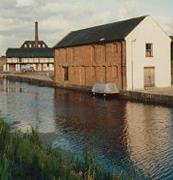
Pit saw (Kennet and Avon Canal Museum collection)

Pill Box on the Kennet and Avon at Bishop's Cannings, Wiltshire
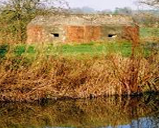
Copyright the Kennet & Avon Trade Association MMXII

|
|
|
|
|
|
|
|
|
|
Sponsored by the Kennet & Avon Trade Association
